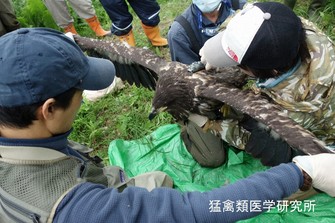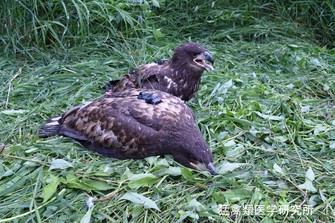
Researchers fit a transmitter onto an eagle born as part of a protection and propagation project by the Ministry of Environment in an urbanization control area on the outskirts of the city of Kushiro, Hokkaido, in this June 2024 photo provided by the Institute for Raptor Biomedicine Japan.
NEMURO, Hokkaido — A solar energy company planning a megaproject near Kushiroshitsugen National Park in Kushiro, Hokkaido, has provided residents with false information about nesting locations of white-tailed eagles, a rare and protected species.
Mainichi Shimbun reporting has uncovered the false statements by renewable energy developer Japan Ecology Corp., based in the city of Osaka, including at a second briefing session for residents held there Feb. 22. The firm asserted, “The nests are outside the proposed development area,” despite findings that multiple nests, including some inactive, were within the site’s boundaries.
The planned development site, situated in an urbanization control area on the outskirts of the city, is roughly rectangular, measuring about 180 by 135 meters. The Mainichi Shimbun examined geographic information system (GIS)-based aerial photos including land parcel numbers obtained from the Kushiro Municipal Government’s property tax division.

A female white-tailed eagle believed to be currently incubating eggs is seen in an urbanization control area on the outskirts of the city of Kushiro, Hokkaido, March 15, 2025, in this partially modified photo provided by the Institute for Raptor Biomedicine Japan.
After requesting location info for the site’s four corners and determining their latitude and longitude, the actual land designated was found to be located more than 40 meters southwest of what was indicated on a map the company distributed at its initial residents’ briefing on Dec. 14 last year. Additional GIS analysis based on coordinates of eagle nests, both active and inactive, provided by multiple sources confirmed that all the nests were clearly within the project area.
Citing inquiry results from an environmental consultancy, Japan Ecology stated at last month’s meeting, “White-tailed eagle nests were on adjacent land, but approximately 5 to 6 meters outside our development’s boundaries.” The firm asserted it would stick with the original project plan while ensuring that construction would be limited as much as possible and heavy machinery that was not noisy would be used during breeding season to minimize the impact on the eagles.
At the first briefing, a map of seven sites planned for use in the project, overlaid on Google Maps and framed in red, was distributed to all participants. For all seven sites, residents were told that there were no white-tailed eagle nests.
Japan Ecology sales department manager Akio Oi told the Mainichi of the discrepancy, “We plan to conduct surveys, and based on the results will comprehensively decide whether to proceed or abandon our plans (for the land in question).”
When people or construction are near nesting sites during breeding season, white-tailed eagles judge the location to be unsuitable and abandon them. Since the nest-building season is believed to have already begun, “Starting to survey now would mean a good chance that mates will give up breeding this year,” one researcher is warning.
‘Land where breeding is successful every year’: expert
Keisuke Saito of the Institute for Raptor Biomedicine Japan, who has been studying birds of prey in the area since 2013, remarked, “There are multiple nests within the proposed project site, and breeding is successful there virtually every year.”

Two eaglets fitted with satellite transmitters are seen in an urbanization control area on the outskirts of the city of Kushiro, Hokkaido, in spring 2024 in this photo provided by the Institute for Raptor Biomedicine Japan.
Saito shared data about breeding success over the last 12 years. Citing the 17 birds that have successfully left the nest, with 20 hatched in total, he said the site had an “extremely good track record for breeding.” The surrounding areas are wetlands, unsuited for nesting as they have little forest cover. As residential development also encroaches, the birds are evidently managing to continue breeding within an isolated island of suitable habitat.
The white-tailed eagle is a nationally designated Natural Monument and categorized as a rare species under Japan’s endangered species conservation law. In 2024, when new birds were raised in the area for the first time in three years, satellite trackers were fitted onto the chicks to collect data on their range of activity, among other things.
When public works projects or logging are proposed, the national government and authorities in Hokkaido have conducted preliminary environmental surveys and taken protective measures to ensure breeding and other activities are not interfered with in accordance with the law.
Kiyoshi Taira, head of the road planning division of Kushiro’s development and construction office, noted, “To minimize impacts on nesting, when a nest is identified, we consult with experts to consider a detour route that is a considerable distance from it.”
At the Feb. 22 briefing, Saito had asked for the project to be reviewed, stating, “Areas within a 500-meter radius of nesting sites are generally off-limits, and care must be taken to ensure that the mating pairs can continue to breed in the same location.”
(Japanese original by Hiroaki Homma, Nemuro Bureau)


AloJapan.com